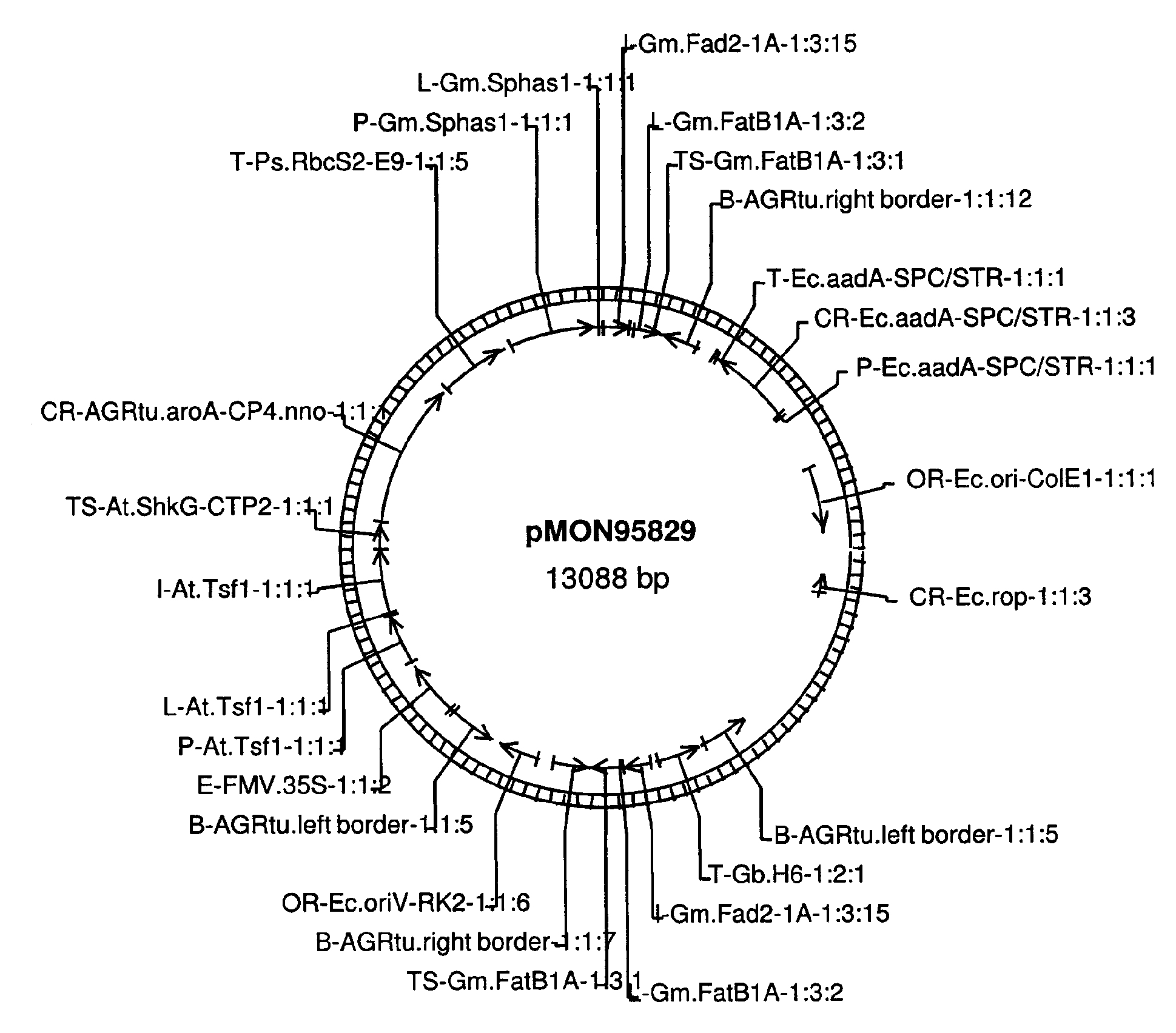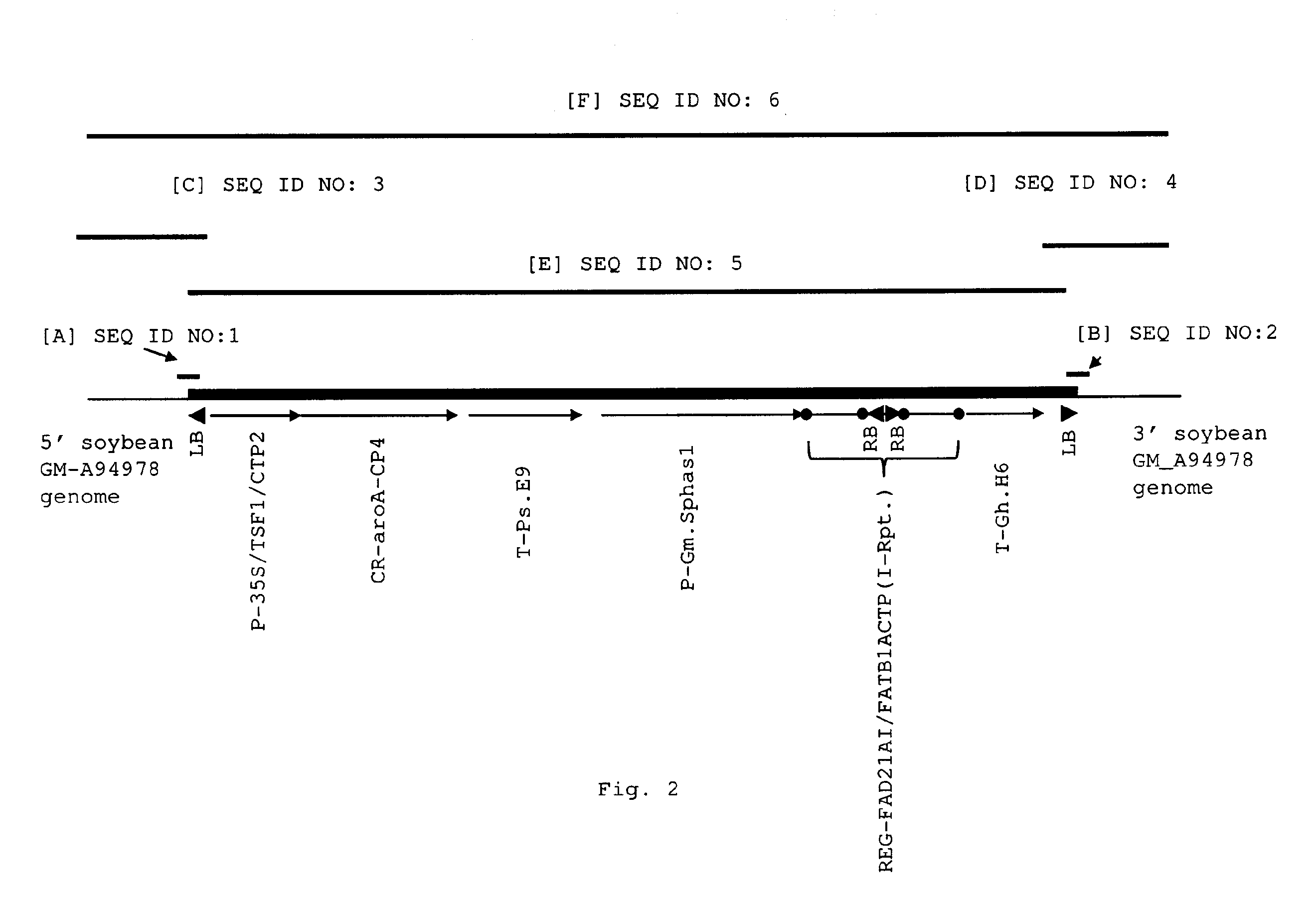Soybean Transgenic Event MON87705 and Methods for Detection Thereof
a technology of transgenic soybean and mon87705, which is applied in the field of transgenic soybean event mon87705, can solve the problems of insufficient availability of soybean oil, lack of important food quality property, and high price of prior soybean oil
- Summary
- Abstract
- Description
- Claims
- Application Information
AI Technical Summary
Benefits of technology
Problems solved by technology
Method used
Image
Examples
example 1
Transformation of Soybean A3525 with pMON95829 and Event Selection
[0081]The transgenic soybean plant MON87705 was generated by an Agrobacterium-mediated transformation of soybean cells with DNA fragments derived from pMON95829 (FIG. 1). The binary plant transformation vector, pMON95829 contains two plant transformation T-DNAs. Each T-DNA was flanked by right border (RB) and left border (LB) sequences at the ends of the T-DNAs. Post transformation screening of MON87705 identified a right border to right border co-integration of the two T-DNAs generating a two cassette insertion, one designed to express the aroA-CP4 gene from Agrobacterium tumefaciens imparting glyphosate tolerance and the other designed with an inverted repeat to trigger the RNAi based suppression of the endogenous FAD2 and FATB genes (SEQ ID NO: 7). The inverted repeat structure is not found in pMON95829, but is formed with a RB to RB co-integration of the two T-DNAs. This integration configuration yields a single t...
example 2
Isolation of Flanking Sequences Using Inverse PCR
[0085]Sequences flanking the T-DNA insertion in MON87705 were determined using inverse PCR as described in Ochman et al., 1990 (PCR Protocols: A guide to Methods and Applications, Academic Press, Inc.) and by TAIL (Thermal Asymmetric InterLaced) PCR. Plant genomic DNA was isolated from both wild-type A3525 and the transgenic line from tissue grown under green house conditions. Frozen leaf tissue was ground by mortar and pestle with liquid nitrogen or mechanical grinding. A volume of 22 mL of extraction buffer was added to ˜1 g of ground leaf tissue and incubated at 65° C. for 1 hour. The CTAB extraction buffer consisted of 1.4M NaCl, 2% CTAB, 20 mM EDTA, and 100 mM Tris-HCl pH 8.0. Just prior to use, 0.02% beta-mercaptoethanol and 0.5 mg RNase A was added to the extraction buffer. The samples were extracted with 12 mL of phenol / chloroform / isoamyl alcohol (25:24:1) solution and then centrifuged at 4000×G for 10 minutes at 4° C. The sup...
example 3
Event-Specific Endpoint Taqman and Zygosity Assays
[0090]The methods used to identify event MON87705 in a sample are event-specific endpoint TaqMan PCR assays for which examples of conditions are described in Table 2 and Table 3. The first set of DNA primers that may be used in the endpoint assays are primers SQ20129 (SEQ ID NO: 8), SQ20130 (SEQ ID NO: 9) and 6FAM™ labeled primer PB10043 (SEQ ID NO: 10). The second set of DNA primers that may be used in the endpoint assays are primers SQ21928 (SEQ ID NO:11), SQ20901 (SEQ ID NO:12), and 6FAM™ labeled primer PB10164 (SEQ ID NO:13). 6FAM™ is a fluorescent dye product of Applied Biosystems (Foster City, Calif.) attached to the DNA primers. For TaqMan MGB (Minor Groove Binding) probes, the 5′exonuclease activity of Taq DNA polymerase cleaves the probe from the 5′-end, between the fluorophore and quencher. When hybridized to the target DNA strand, quencher and fluorophore are separated enough to produce a fluorescent signal.
[0091]SQ20129 (...
PUM
| Property | Measurement | Unit |
|---|---|---|
| Fraction | aaaaa | aaaaa |
| Fraction | aaaaa | aaaaa |
| Temperature | aaaaa | aaaaa |
Abstract
Description
Claims
Application Information
 Login to View More
Login to View More - R&D
- Intellectual Property
- Life Sciences
- Materials
- Tech Scout
- Unparalleled Data Quality
- Higher Quality Content
- 60% Fewer Hallucinations
Browse by: Latest US Patents, China's latest patents, Technical Efficacy Thesaurus, Application Domain, Technology Topic, Popular Technical Reports.
© 2025 PatSnap. All rights reserved.Legal|Privacy policy|Modern Slavery Act Transparency Statement|Sitemap|About US| Contact US: help@patsnap.com



